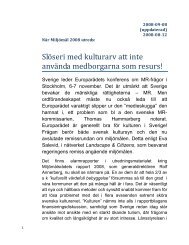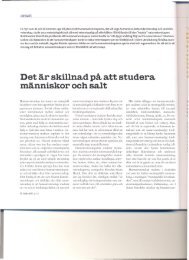Landscape through literature Le paysage à travers la littérature
Landscape through literature Le paysage à travers la littérature
Landscape through literature Le paysage à travers la littérature
You also want an ePaper? Increase the reach of your titles
YUMPU automatically turns print PDFs into web optimized ePapers that Google loves.
94<br />
C O U N C I L O F E U R O P E / C O N S E I L D E L ’ E U R O P E<br />
European <strong>Landscape</strong> Convention<br />
Florence, 20 October 2000<br />
Preamble<br />
The member States of the Council of Europe signatory<br />
hereto,<br />
Considering that the aim of the Council of Europe is to<br />
achieve a greater unity between its members for the<br />
purpose of safeguarding and realising the ideals and<br />
principles which are their common heritage, and that<br />
this aim is pursued in particu<strong>la</strong>r <strong>through</strong> agreements in<br />
the economic and social fields;<br />
Concerned to achieve sustainable development based<br />
on a ba<strong>la</strong>nced and harmonious re<strong>la</strong>tionship between<br />
social needs, economic activity and the environment;<br />
Noting that the <strong>la</strong>ndscape has an important public interest<br />
role in the cultural, ecological, environmental and social<br />
fields, and constitutes a resource favourable to economic<br />
activity and whose protection, management and p<strong>la</strong>nning<br />
can contribute to job creation;<br />
Aware that the <strong>la</strong>ndscape contributes to the formation of<br />
local cultures and that it is a basic component of the European<br />
natural and cultural heritage, contributing to human<br />
well-being and consolidation of the European identity;<br />
Acknowledging that the <strong>la</strong>ndscape is an important part<br />
of the quality of life for people everywhere: in urban<br />
areas and in the countryside, in degraded areas as well<br />
as in areas of high quality, in areas recognised as being<br />
of outstanding beauty as well as everyday areas;<br />
Noting that developments in agriculture, forestry, industrial<br />
and mineral production techniques and in regional<br />
p<strong>la</strong>nning, town p<strong>la</strong>nning, transport, infrastructure, tourism<br />
and recreation and, at a more general level, changes in<br />
the world economy are in many cases accelerating the<br />
transformation of <strong>la</strong>ndscapes;<br />
Wishing to respond to the public’s wish to enjoy high<br />
quality <strong>la</strong>ndscapes and to p<strong>la</strong>y an active part in the development<br />
of <strong>la</strong>ndscapes;<br />
Believing that the <strong>la</strong>ndscape is a key element of individual<br />
and social well-being and that its protection,<br />
management and p<strong>la</strong>nning entail rights and responsibilities<br />
for everyone;<br />
Having regard to the legal texts existing at international<br />
level in the field of protection and management of the<br />
natural and cultural heritage, regional and spatial p<strong>la</strong>nning,<br />
local self-government and transfrontier co-operation,<br />
in particu<strong>la</strong>r the Convention on the Conservation<br />
of European Wildlife and Natural Habitats (Bern,<br />
19 September 1979), the Convention for the Protection<br />
of the Architectural Heritage of Europe (Granada,<br />
3 October 1985), the European Convention on the<br />
Protection of the Archaeological Heritage (revised)<br />
(Valletta, 16 January 1992), the European Outline<br />
n a t u r o p a n o 1 0 3 / 2 0 0 5<br />
Convention on Transfrontier Co-operation between Territorial<br />
Communities or Authorities (Madrid, 21 May 1980)<br />
and its additional protocols, the European Charter of<br />
Local Self-government (Strasbourg, 15 October 1985),<br />
the Convention on Biological Diversity (Rio, 5 June 1992),<br />
the Convention concerning the Protection of the World<br />
Cultural and Natural Heritage (Paris, 16 November 1972),<br />
and the Convention on Access to Information, Public<br />
Participation in Decision-making and Access to Justice on<br />
Environmental Matters (Aarhus, 25 June 1998);<br />
Acknowledging that the quality and diversity of European<br />
<strong>la</strong>ndscapes constitute a common resource, and that<br />
it is important to co-operate towards its protection,<br />
management and p<strong>la</strong>nning;<br />
Wishing to provide a new instrument devoted exclusively<br />
to the protection, management and p<strong>la</strong>nning of all <strong>la</strong>ndscapes<br />
in Europe,<br />
Have agreed as follows:<br />
Chapter I – General provisions<br />
Article 1 – Definitions<br />
For the purposes of the Convention:<br />
a. “<strong>Landscape</strong>” means an area, as perceived by people,<br />
whose character is the result of the action and interaction<br />
of natural and/or human factors;<br />
b. “<strong>Landscape</strong> policy” means an expression by the competent<br />
public authorities of general principles, strategies<br />
and guidelines that permit the taking of specific measures<br />
aimed at the protection, management and p<strong>la</strong>nning<br />
of <strong>la</strong>ndscapes;<br />
c. “<strong>Landscape</strong> quality objective” means, for a specific<br />
<strong>la</strong>ndscape, the formu<strong>la</strong>tion by the competent public<br />
authorities of the aspirations of the public with regard<br />
to the <strong>la</strong>ndscape features of their surroundings;<br />
d. “<strong>Landscape</strong> protection” means actions to conserve<br />
and maintain the significant or characteristic features<br />
of a <strong>la</strong>ndscape, justified by its heritage value derived<br />
from its natural configuration and/or from human<br />
activity;<br />
e. “<strong>Landscape</strong> management” means action, from a<br />
perspective of sustainable development, to ensure the<br />
regu<strong>la</strong>r upkeep of a <strong>la</strong>ndscape, so as to guide and<br />
harmonise changes which are brought about by social,<br />
economic and environmental processes;<br />
f. “<strong>Landscape</strong> p<strong>la</strong>nning” means strong forward-looking<br />
action to enhance, restore or create <strong>la</strong>ndscapes.<br />
Article 2 – Scope<br />
Subject to the provisions contained in Article 15, this<br />
Convention applies to the entire territory of the Parties and<br />
covers natural, rural, urban and peri-urban areas. It<br />
includes <strong>la</strong>nd, in<strong>la</strong>nd water and marine areas. It concerns<br />
<strong>la</strong>ndscapes that might be considered outstanding as well<br />
as everyday or degraded <strong>la</strong>ndscapes.<br />
Article 3 – Aims<br />
The aims of this Convention are to promote <strong>la</strong>ndscape<br />
protection, management and p<strong>la</strong>nning, and to organise<br />
European co-operation on <strong>la</strong>ndscape issues.<br />
Chapter II – National measures<br />
Article 4 – Division of responsibilities<br />
Each Party shall implement this Convention, in particu<strong>la</strong>r<br />
Articles 5 and 6, according to its own division of powers,<br />
in conformity with its constitutional principles and administrative<br />
arrangements, and respecting the principle of<br />
subsidiarity, taking into account the European Charter of<br />
Local Self-government. Without derogating from the<br />
provisions of this Convention, each Party shall harmonise<br />
the implementation of this convention with its own policies.<br />
Article 5 – General measures<br />
Each Party undertakes:<br />
a. to recognise <strong>la</strong>ndscapes in <strong>la</strong>w as an essential component<br />
of people’s surroundings, an expression of the<br />
diversity of their shared cultural and natural heritage,<br />
and a foundation of their identity;<br />
b. to establish and implement <strong>la</strong>ndscape policies aimed<br />
at <strong>la</strong>ndscape protection, management and p<strong>la</strong>nning<br />
<strong>through</strong> the adoption of the specific measures set out<br />
in Article 6;<br />
c. to establish procedures for the participation of the<br />
general public, local and regional authorities, and<br />
other parties with an interest in the definition and<br />
implementation of the <strong>la</strong>ndscape policies mentioned<br />
in paragraph b above;<br />
d. to integrate <strong>la</strong>ndscape into its regional and town p<strong>la</strong>nning<br />
policies and in its cultural, environmental, agricultural,<br />
social and economic policies, as well as in any<br />
other policies with possible direct or indirect impact<br />
on <strong>la</strong>ndscape.<br />
Article 6 – Specific measures<br />
A. Awareness-raising<br />
Each Party undertakes to increase awareness among the<br />
civil society, private organisations, and public authorities<br />
of the value of <strong>la</strong>ndscapes, their role and changes to<br />
them.<br />
B. Training and education<br />
Each Party undertakes to promote:<br />
a. training for specialists in <strong>la</strong>ndscape appraisal and<br />
operations;<br />
b. multidisciplinary training programmes in <strong>la</strong>ndscape<br />
policy, protection, management and p<strong>la</strong>nning, for<br />
professionals in the private and public sectors and for<br />
associations concerned;<br />
c. school and university courses which, in the relevant<br />
subject areas, address the values attaching to <strong>la</strong>ndscapes<br />
and the issues raised by their protection,<br />
management and p<strong>la</strong>nning.<br />
C. Identification and assessment<br />
1. With the active participation of the interested parties,<br />
as stipu<strong>la</strong>ted in Article 5.c, and with a view to improving<br />
knowledge of its <strong>la</strong>ndscapes, each Party undertakes:<br />
a. i) to identify its own <strong>la</strong>ndscapes <strong>through</strong>out its territory;





